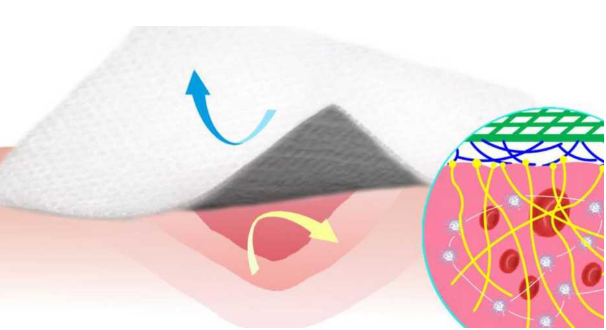New bandage material aids blood-clotting and doesn’t stick

Researchers at ETH Zurich and the National University of Singapore have developed a novel wound dressing that has a haemostatic effect and does not stick to the wound. This is the first time that the scientists have combined the two properties in one material.
"Actually, it wasn't planned that way, but that's how science sometimes works: You start researching on one thing and end up somewhere else," says ETH Professor Dimos Poulikakos. Together with scientists from his research group and from the National University of Singapore, he tested various super-hydrophobic materials - i.e. those that, like Teflon, repel liquids such as water and blood extremely well. The aim was to find coating materials for devices that come into contact with blood, such as heart-lung machines or artificial hearts.
One of the materials tested showed unexpected properties: it not only repelled blood, but also caused it to clot. The material was therefore unsuitable for coating a blood pump. However, the scientists quickly realized that this material was an excellent wound dressing.
Blood-repellent and coagulation-promoting are two different properties, but both are advantageous in wound dressings: Blood-repellent dressings do not absorb blood, do not stick to the wound and can therefore be removed more easily later. Coagulation-promoting substances and materials, on the other hand, are used in medicine to stop bleeding as quickly as possible. However, materials that are both blood-repellent and promote blood coagulation were not available until now. For the first time, scientists are bringing these two properties together in one material.
Antibacterial effect
The researchers coated a classic cotton gauze fabric with the new material - a mixture of silicone and carbon nanofibres. In laboratory tests, the scientists were able to show that blood coagulates within just a few minutes when it comes into contact with the coated gauze. Why exactly the new material triggers blood coagulation is still unclear and is the subject of further research. However, the scientists suspect that the carbon fibers are responsible for this.
The researchers were also able to show that the coated gauze has an antibacterial effect - because bacteria only adhere poorly to the surface. The scientists also confirmed the effectiveness of the new wound dressing in tests with rats.
Reducing the risk of infection
"With the new super-hydrophobic material, it is possible to prevent the wound from tearing open again when the dressing is changed," explains Athanasios Milionis, a post-doctoral fellow in Poulikakos' group. "Rreopening is a major problem, because of the risk of infection - especially with dangerous hospital germs - which is particularly pronounced during dressing changes".
The future areas of application are very broad: in emergency medicine and surgery to prevent major blood loss, but also as adhesive plasters in home and travel pharmacies.
ETH Zurich and the National University of Singapore have applied for patents for the new material. Before it can be used in humans, the researchers must further develop and optimize the material. According to the scientists, further trials are also necessary, first in other animal species and then in humans, to prove its safety and effectiveness.
Source (German): https://ethz.ch/content/main/de/news-und-veranstaltungen/eth-news/news/2020/01/neuartiges-verbandmaterial-wirkt-blutstillend-und-verklebt-nicht.html
Image Source: Li Z et al. Nature Communications 2019
Original article: https://www.nature.com/articles/s41467-019-13512-8